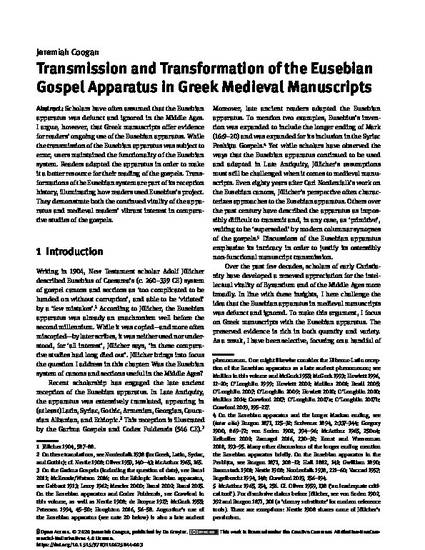
Contribution to Book
Transmission and Transformation of the Eusebian Gospel Apparatus in Greek Medieval Manuscripts
Jesuit School of Theology
Document Type
Book Chapter
Publication Date
1-1-2020
Publisher
Walter de Gruyter GmbH
Disciplines
Abstract
Scholars have often assumed that the Eusebian apparatus was defunct and ignored in the Middle Ages. I argue, however, that Greek manuscripts offer evidence for readers’ ongoing use of the Eusebian apparatus. While the transmission of the Eusebian apparatus was subject to error, users maintained the functionality of the Eusebian system. Readers adapted the apparatus in order to make it a better resource for their reading of the gospels. Trans-formations of the Eusebian system are part of its reception history, illuminating how readers used Eusebius’s project. They demonstrate both the continued vitality of the appa-ratus and medieval readers’ vibrant interest in compara-tive studies of the gospels.
Chapter of
Canones: The Art of Harmony
Editor
Alessandro Bausi Bruno Reudenbach
Hanna Wimmer
Citation Information
Coogan, J. (2020). Transmission and Transformation of the Eusebian Gospel Apparatus in Greek Medieval Manuscripts. In A. Bausi, B. Reudenbach, & H. Wimmer (Eds.), Canones: The Art of Harmony (pp. 29–46). De Gruyter. https://doi.org/10.1515/9783110625844-003

Open Access. © 2020 Jeremiah Coogan, published by De Gruyter. This work is licensed under the Creative Commons Attribution-NonCom-mercial-NoDerivatives 4.0 License.